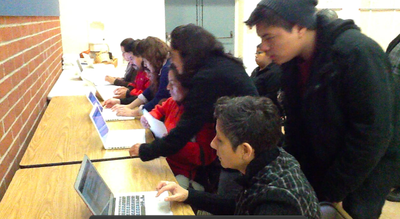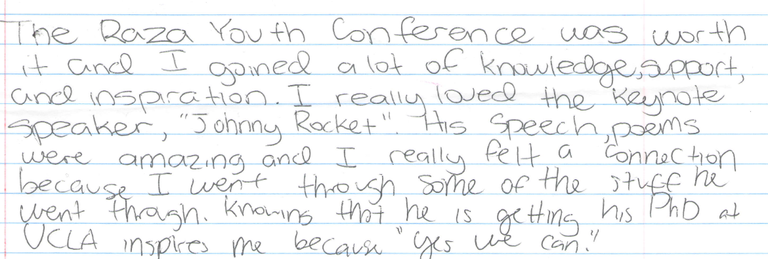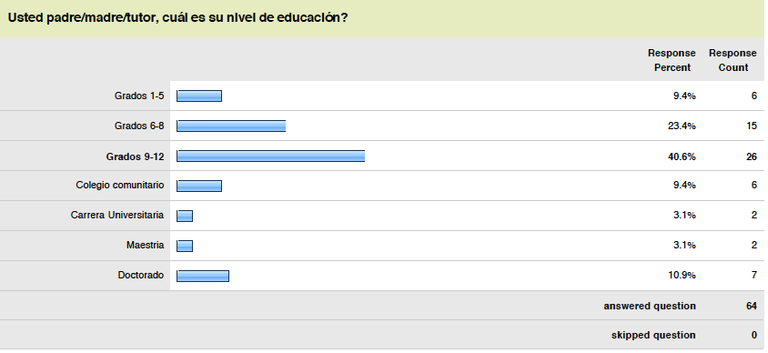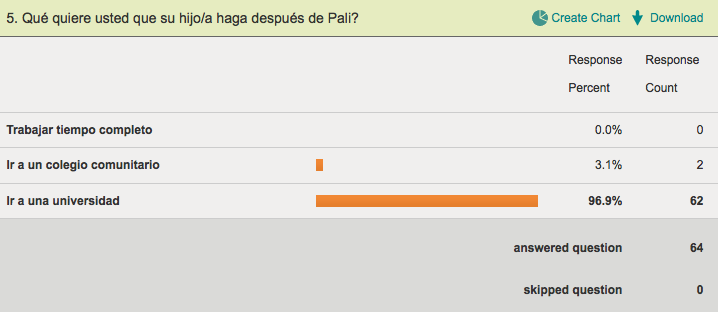Action Research Leadership Project Narrative and Outcomes
Creating a College Culture Among Latino Students at Pali
Summary
Rationale
 College access for all, which comes from high quality education, is the most important job of our society. There are many reasons why pursuing higher education is one of the most valuable assets all students can accomplish. In today’s economy, high school graduates are unable to obtain the number of high paying jobs that were once available. In addition, when students experience a post secondary education, they have the opportunity to enhance learning and listen to the experts in their respective fields. This provides them additional growth and development which will make them more competitive in today’s job market. Furthermore, during their college journey, students have the opportunity to expand their social capital that will give them more options when they begin their job search. Overall, college access serves as the gateway to better options and more opportunity.
College access for all, which comes from high quality education, is the most important job of our society. There are many reasons why pursuing higher education is one of the most valuable assets all students can accomplish. In today’s economy, high school graduates are unable to obtain the number of high paying jobs that were once available. In addition, when students experience a post secondary education, they have the opportunity to enhance learning and listen to the experts in their respective fields. This provides them additional growth and development which will make them more competitive in today’s job market. Furthermore, during their college journey, students have the opportunity to expand their social capital that will give them more options when they begin their job search. Overall, college access serves as the gateway to better options and more opportunity.
Unfortunately, although this country is one of the leaders in the world, its educational system has been denying students the opportunity to college access especially for students of color. According to Oakes et al. (2006), out of 100 9th grade students only 69 graduated from high school and only 26 percent were college-ready graduates at the end of their high school career in 2004. These numbers are even lower for students of color. For every 100 Latino, African American, and American Indian 9th graders, only 9 graduated within four years with the courses required for UC and CSU. At Pali for every 100 9th graders from its 2007 cohort, 52 graduated with the courses required for UC/CSU; however when I disseminated this information I found that only about 28 out of 100 graduated with the courses required for UC/CSU. This alarming data encouraged me to be the leader of this action research project that focuses in the creating of a college going culture among the Latino community at Pali.
Tasks, Activities, Challenges and Changes
 A great component on creating a college going culture at a school is parental involvement. At the beginning of my action research leadership project I wanted to find out where my Latino parents were in regards of this topic so I had planned to survey them using surveymonkey.com. With the collaboration of teachers, counselors and administrators who are part of Fuerza Unida and students from the Latino Student Union we were able to plan three parent meetings. For my Latino parent meeting in November I created a survey asking parents general questions about their thoughts about college. In order for the parents to take the survey I worked with the Technology department to set up laptops in Mercer Hall at 8:00 am for parents to take the survey before the meeting. I had not planned or expected so many challenges with activity. One challenge was that although I requested 40 laptops many were not working, many couldn’t connect to the internet, a very high percentage of parents had never used a computer before so had difficulties completing the survey and many didn’t understand the survey questions. Based on this experience I had to modify my data collection strategy and used checklists and focus groups for the following meeting.
A great component on creating a college going culture at a school is parental involvement. At the beginning of my action research leadership project I wanted to find out where my Latino parents were in regards of this topic so I had planned to survey them using surveymonkey.com. With the collaboration of teachers, counselors and administrators who are part of Fuerza Unida and students from the Latino Student Union we were able to plan three parent meetings. For my Latino parent meeting in November I created a survey asking parents general questions about their thoughts about college. In order for the parents to take the survey I worked with the Technology department to set up laptops in Mercer Hall at 8:00 am for parents to take the survey before the meeting. I had not planned or expected so many challenges with activity. One challenge was that although I requested 40 laptops many were not working, many couldn’t connect to the internet, a very high percentage of parents had never used a computer before so had difficulties completing the survey and many didn’t understand the survey questions. Based on this experience I had to modify my data collection strategy and used checklists and focus groups for the following meeting.
The focus of this meeting was to educate and empower Latino parents by providing them valuable information about what the A-G requirements are. With this, another challenge that I faced during this parent meeting was that we needed more help distributing the students’ transcripts to parents. I had planned to distribute them from 8:30 am to 9:00 am and begin the meeting at 9:00 am, but this was not possible. More than 300 parents went to the meeting creating long lines to get their children’s transcript. Based on these situations I realized that I needed to spend a lot more time planning and working together on detailed plans with Fuerza Unida and the Technology Office in order to minimize unexpected situations.
I conducted another leadership task in February for Latino parents. I only invited parents whose child had one or more F’s for Fall 2011. I was very surprised to see that the number of Latino parents who had RSVPd was much higher than the number that participated at the meeting. My biggest challenge for this meeting was to ensure that all parents who were invited obtained the valuable information presented to them at the meeting. I thought of sending a packet to absent parents to their home, but with budget cuts this was not possible, so I sent this packet with students to take to their parents. I have no data on whether or not parents received the packets from their child.
In order to create a college going culture, schools must create links between K-12 schools and local colleges and universities that can lead to field trips, college fairs, and academic enrichment programs, based on this I planned two college visits this year. The first visit was to UCI and the second to CSUN. The focus of these two college visits was to educate Latino students about college requirements, college campus culture, and introduce them to college going Latino students who can share with them their experience.
I met with the Latino Student Union every Monday and Tuesday during lunch in my room C204. These laboratories of democracy meetings provided a physical space where Latino students met to talk about their high school experience, challenges, celebrations and to gain priceless knowledge about accessing college. At these meeting students also had the opportunity to lead discussions about how to influence policies that benefit students and support the improvement of teaching and learning of all students.
To develop a college culture among the Latino students I conducted clear and ongoing communication about college so that all students develop a college-going identity. To help me with this philosophy I brought to Pali and amazing documentary “First Generation”. This documentary tells the story of four high school students - an inner city athlete, a small town waitress, a Samoan warrior dancer, and the daughter of migrant field workers - who set out to break the cycle of poverty and bring hope to their families and communities by pursuing a college education. Students were engaged and identified themselves with the real life documentary.

One of the biggest challenges while conduction my action research leadership project is not having a budget. Part of creating a college culture among the Latino community focuses on creating college partnerships and doing college visits. College visits require to pay for a bus that runs between $600-$800 additionally teachers must be covered to chaperone the trip and this requires a budget. Also, bringing to Pali the documentary “First Generation” required a budget. To solve this problem I led different activities to raise funds. 1) The Latino Student Union (LSU) sold tamales, pupusas, champurrado and pan dulce at every event. LSU also sold t-shirts and patches. I worked with my principal a plan in which she helped to pay for half of a couple of activities and the other half was paid by Fuerza Unida/LSU, and last, I wrote a grant to the Booster club asking for donations and it granted us $2225.
Data Findings
Although there were some challenges throughout the implementation of my action research leadership project, I was able to gather important data that can be used to better serve our Latino parents and students at Pali.
Parental Involvement
Latino parent seminars/workshops
Sixty-four parents of the first Latino parent seminar conducted in November said that 3.1%6 had a BA/BS degree, 3.1% had a master’s degree, and 10.9% had a doctorate degree. Based on more than ten years of experience working with Latino parents and students at Pali I found this data to be shocking. About 95% of conversations with Latino parents and students that I have engaged with have stated the fact that Latino parents don’t have a college. What was not shocking is to look at the data that stated that 96.9% of Latino parents want their kids to go to a four-year college right after high Pali. Fifty-three point one percent said that they new who their child’s counselor was but 0% were able to write the name of the counselor when asked to do so. Just about 50% of the Latino parents said that they could, read, write and speak in English. When asked if they knew what the A-G requirements are 51.6% said that they knew what they are. However, when we conducted the meeting as we asked parents to share what they new about the A-G requirements not a single parent gave any information. 32.8% said that they don’t know what the difference is between a community college and a four-year college and 34.4% said they didn’t know what Honors and AP classes are.

For the focus group that I conducted in February these is the data that I collected from it.
Reasons Latino parents gave about why their child is failing his/her classes at Pali.
- Students can’t understand their math teacher (teachers' accent)
- Classes are very difficult
- Doesn’t understand the content
- Can’t switch teachers
Other issues that came up:
1. Teachers and counselors don’t respond to calls, emails and notes
2. No more teleparent- they feel that this is very important
3. Too many substitutes who do not care about the coursework and the students
4. Teachers not filling out weekly progress report card.

College Visits
One college visits that I planned for my action research project was to CSUN. Many students couldn’t be part of this college visit because it was on a Saturday and did not have transportation either because their parents work during the weekend and/or their parents don’t drive. After the trip I had a focus group to gather information about what the students thought about the trip. All students said that the trip was worth going on a Saturday. Most strongly agreed that Johnny Rocket was a very inspirational keynote speaker and could connect to his counterstory because they have faced the same difficulties in their communities and school as his. And, most strongly agreed that it was important for schools to give them the experience to work with community leaders who are fighting to influence education policy to better serve their needs.

College Talk
“First Generation”
The students defined “First Generation” as “the best documentary I’ve ever seen”. After the documentary I had a focus group. Students shared the profound connection they had with the documentary. Many became very emotional and couldn’t stop crying because they literally saw themselves as the students in the film. The most salient comment they said was that the movie helped them see how blessed they are to be at Pali and that this film has empowered them to fight to make their dream of going to college a reality.
As part of this documentary I created a pre-survey and a post-survey that helped me analyze data about how students perceive Pali’s college culture. After comparing the pre-surveys and the post-surveys I will explain the most significant changes. There is a clear maturity and understanding process that develops throughout high school. By senior year students have a much clearer understanding about college requirements.
One data that shocked me was that 38 students of the 9th grade cohort said on the pre-survey that they new what the SAT is, but compared to the post-survey the number dropped to 18 students. In general terms the 10th, 11th and 12th grade cohorts demonstrated a better understanding about college requirements than the 9th grade cohort. However, although seniors said they know what the SAT and ACT are, 10 out of 46 said that they had no taken the SAT, and 36 out of 46 had not taken the ACT.

Recommendations
I was very pleased the way I conducted my action research leadership project. However, even in the best of the cases there is always room for improvement. For next year these are my recommendations:
o Fueza Unida Madrinas should go to a retreat, where they can bond even more and structure a year’s plan to target the needs of Latino students.
o The AVID program has been proven successful in helping Pali students go to a four-year college right after high school, therefore I recommend that AVID be implemented at a larger scale on campus.
o Because it was very difficult to manage PLI, my action research leadership project and a full teaching load, I recommend that in order to investigate, study and improve teaching practices in school action research leader must be supported with out of class time to better analyze data and bring recommendations to the administrators.
o In order to create a college culture at school, I recommend that a specific budget be created for college visits and speakers who are experts in the field.
o College talk must be part of every class.
o Parental involvement must continue.
o Pali’s technology must be updated.
Standards Met
 Standard 1- A school administrator is an educational leader who promotes the successes of all students by facilitating the development, articulation, implementation, and stewardship of a vision of learning that is shared and supported by the school community.
Standard 1- A school administrator is an educational leader who promotes the successes of all students by facilitating the development, articulation, implementation, and stewardship of a vision of learning that is shared and supported by the school community.
Standard 2- A school administrator is an educational leader who promotes the successes of all students by advocating, nurturing, and sustaining a school culture and instructional program conducive to student learning and staff professional growth.
Standard 3 - A school administrator is an educational leader who promotes the successes of all students by ensuring management of the organization, operations, and resources for a safe, efficient, and effective learning environment.
Standard 4 - A school administrator is an educational leader who promotes the successes of all students by collaborating with families and community members, responding to diverse community interests and needs, and mobilizing community resources.
Standard 5 - A school administrator is an educational leader who promotes the successes of all students by modeling a personal code of ethics and developing professional leadership capacity.
Standard 6- A school administrator is an educational leader who promotes the successes of all students by understanding, responding to, and influencing the larger political, social, economic, legal, and cultural context.
Through the meeting with students from the Latino Student Union (LSU), teachers, counselors and administrators from Fuerza Unida we have developed a shared vision of what a college going culture looks like and how it supports our school and students. The meetings through the year were planned and implemented around this vision and college going culture activities were created to ensure integration among the Latino student body at Pali.
By providing the teachers with resources, conversations and observations of college going culture I guided my action research leadership project. I recognized and valued students’ inputs for the inquiry process. We used appropriate and effective technology with different tasks especially for the screening of the documentary “First Generation”. The teachers from Fuerza Unida were able to collaborate and share responsibilities by working together and having meetings where we could discuss ideas. Through LSU’s laboratories of democracy we were able to promote equity, fairness and respect among all members of the school community.
My management, organizational, problem-solving and decision-making techniques where further developed throughout the process of bringing the documentary “First Generation” to Pali. Because of the budget cuts and not having a budget I worked with the LSU to align fiscal, human, and material resources to support the learning of all subgroups of students.
I modeled collaboration with family and community members by leading Latino parent workshops. Through these workshops I was able to respect the goals and aspirations of my Latino parents. One of these goals is to ensure that their child(ren) go to a four year college right after Pali. The focus groups I had with Latino parents gave the opportunity to incorporate information about Latino families’ expectations into school decision-making activities.
I modeled personal and professional fairness in that I participated in meetings to discuss the tracking system at my school that is impeding students of color to take Honors and AP classes. For the implementation of my action research leadership project I protected the rights and confidentiality of students and staff; no names were ever mentioned. For Back to School Night I put into practice my conflict management skills by working together with another teacher to share the quad; the outcome was a win-win situation. Throughout the implementation of my project I engaged in a process of reflection about my personal leadership practices by keeping a daily journal.
By engaging in college partnerships with USC and CSUN I was able to work with local leaders to influence policies that benefit students and support public policies that ensure the equitable distribution of resources and support for all subgroups of students. Additionally going to The InnerCity Struggle (ICS) workshop presented at USC I learned that youth and parents working together are a powerful force for improving their communities and making real change. ICS engages in consistent base-building that involves outreach and education to thousands of youth, parents and community members on issues of educational justice and how they can become involved in the change efforts led by members of ICS.

